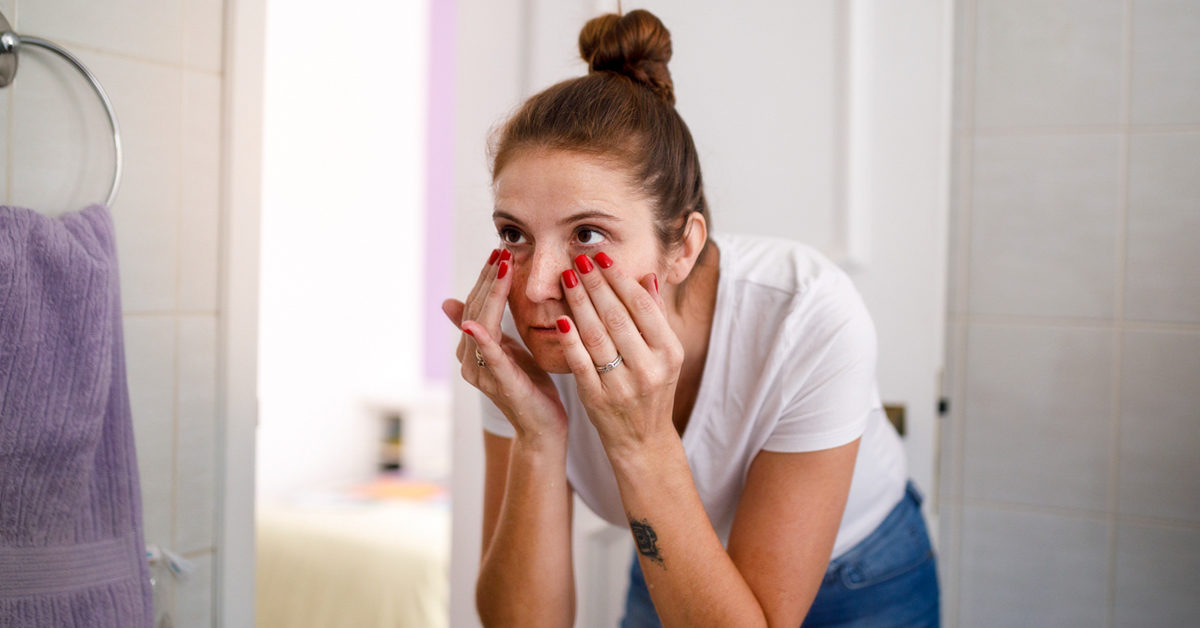
Dennie-Morgan (DM) lines are small creases that form along your lower eyelids. These can lead the appearance of double skin folds beneath your eyes.
Also called Dennie-Morgan folds, these lines aren’t associated with the natural aging process like wrinkles can be. Instead, DM lines tend to develop during early childhood, usually in response to allergies and related immune system reactions.
If you have these creases underneath your eyes and have a history of allergies or eczema, there’s a chance they may be DM lines. A doctor can help you make this determination.
Read on to learn more about the exact causes of DM folds and what treatment options may be available to help reduce their appearance.
Fine lines and deep wrinkles typically form with age, especially after the age of 30, when your skin starts losing collagen and elastin.
Genetics can play a big role in the timing and severity of your wrinkles. Sun exposure, poor diet, stress, and smoking can also increase the risk of premature skin aging.
Wrinkles that form with age tend to develop:
However, DM folds aren’t in the same class as wrinkles associated with aging. Rather than being caused by a loss of elastin and collagen, these lines develop from a genetic predisposition to allergies and eczema.
Genetics
DM lines may be attributed to atopy, a genetic tendency to develop strong immune responses to allergens.
Atopy can lead to the development of allergic diseases. If one of your parents has an allergic disease along with DM lines, you’re at a higher risk for having them, too.
Atopic dermatitis
Commonly known as eczema, atopic dermatitis is extremely common in early childhood, affecting an estimated one in five infants. Eczema itself is linked to inflammation caused by allergic diseases.
While your eczema may improve as an adult, you may still be left with the DM lines associated with this condition. In some cases, the presence of DM lines may also serve as just one diagnostic criteria for eczema.
Allergic rhinitis
Also called “hay fever,” allergic rhinitis is strongly linked with DM lines.
When you have allergic rhinitis, your immune system mistakenly treats harmless substances as intruders, leading to a cascade of symptoms that affect your eyes, nose, ears, throat, and skin.
Aside from allergy symptoms, a notable trait of someone who has allergic rhinitis is dark undereye circles (called “shiners”).
If you have hay fever, you may have both DM lines and dark circles underneath your eyes. Persistent nasal congestion from hay fever is thought to contribute to both of these undereye features.
Asthma
If you have moderate to severe allergies, you may be at an increased risk of allergic asthma. Atopy is also associated with inhaled allergens.
Thus, there may be a connection between allergy-induced asthma and DM folds.
DM lines tend to form during childhood alongside allergic diseases. However, the creases may become more noticeable as you age.
Treatment for DM folds primarily involves addressing the underlying causes, but some cosmetic treatments may help, too. Discuss the following options with a doctor.
Allergy medications
To treat allergic rhinitis, a doctor may recommend both an antihistamine and decongestant. Allergy shots may offer more long-term relief.
While allergy treatments won’t get rid of DM lines alone, they can decrease inflammation and reduce the appearance of allergic shiners.
Blepharoplasty
In the case of severe DM lines and sagging skin, a dermatologist may recommend blepharoplasty as a permanent treatment. This surgical procedure targets excess skin and sagginess under your eyes to help smooth out any lines and wrinkles.
As with other cosmetic surgeries, blepharoplasty may carry the risk of:
- infections
- bleeding
- scarring
This procedure is only reserved for the most significant cases of undereye wrinkles and sagging skin. It’s not designed to treat mild to moderate DM lines.
Dermal fillers
Dermal fillers are injectable treatments designed to help fill in lines and wrinkles with temporary substances like hyaluronic acid and collagen.
You’ll need follow-up treatments once the injections wear off after several months. Side effects may include temporary bruising and swelling.
Laser therapy
Some forms of laser therapy have also been studied as possible treatment options for allergic shiners and DM folds.
However, this high-powered laser treatment may not be suitable for all skin types. Side effects can include:
- redness
- scarring
- hyperpigmentation
Chemical peels
A dermatologist may recommend a chemical peel as a way to smooth out undereye lines and reduce their overall appearance. These peels contain acids, such as glycolic, lactic, or citric acid.
Avoid chemical peels if you have any of the following conditions:
In these cases, chemical peels may lead to skin rashes.
Topical creams
Eye wrinkle creams containing vitamins C, hyaluronic acid, peptides, and ceramides may all help reduce the appearance of DM lines as well as inflammation.
You’ll need to use them every day to achieve their full effect. Avoid undereye creams that contain alcohol and fragrances, as these may cause eczema flare-ups.
Dennie-Morgan lines are associated with allergic diseases, including eczema and hay fever.
These undereye folds aren’t the same types of wrinkles you may experience with aging skin, so it’s important to keep in mind that the overall treatment approach may be different.
While allergy management ought to be your first objective, you may also be able to reduce the appearance of DM lines via cosmetic treatments.
Talk to a dermatologist to see which options might work best for you.
